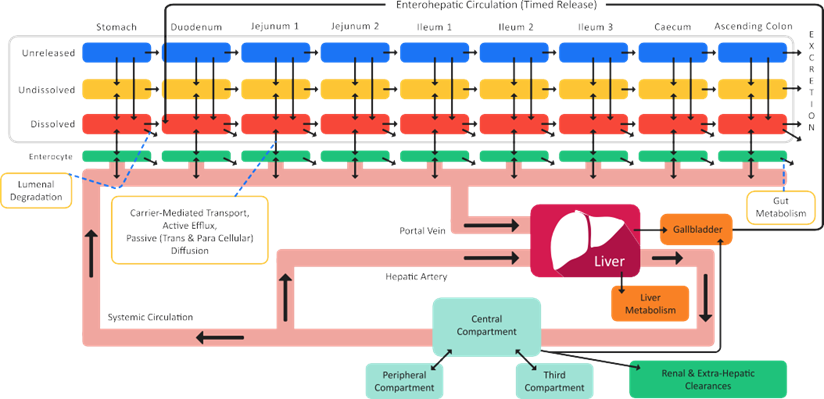ACAT Model Schematic
The ACAT model was developed based on the CAT model to include first-pass metabolism and colonic absorption. Figure 1-1 is a schematic of the ACAT model. The purpose of this schematic is to conceptually illustrate the ACAT model interpretation of in vivo drug behavior.
Figure 1-1: ACAT model schematic

The ACAT model includes the following variables:
Six states of drug: Unreleased, Undissolved, Dissolved, Degraded, Metabolized, and Absorbed.
Nine gastrointestinal (GI) tract compartments: The stomach, six segments of the small intestine, the caecum, and the ascending colon.
Four sub-compartments for each GI tract compartment: Unreleased, Undissolved, Dissolved, and Enterocyte.
Three states of excreted material: Unreleased, Undissolved, and Dissolved.
The unreleased row of sub-compartments is used only for controlled release (CR) dosage forms. For controlled release, the drug can be released into solution (dissolved) or as solid particles (undissolved). Undissolved drug undergoes dissolution and becomes available for absorption, lumenal degradation, and carrier-mediated transport. Undissolved (solid particles) and dissolved (drug in solution) drug undergoes first-order transit through the GI tract. Drug is eventually excreted from the colon if it is not absorbed before the end of the transit process.
Drug is considered to be absorbed in GastroPlus® when it enters the enterocytes. Drug absorption can be passive and driven by the concentration gradient across the apical membrane, or it can be mediated by influx and efflux transporters in the enterocytes.
Absorbed drug can be subject to metabolism in the enterocytes. In GastroPlus®, the enterocytes act as well-mixed tanks where efflux, basolateral transport, and gut metabolism compete for the drug.

Drug is considered to be absorbed in GastroPlus® when it enters the enterocytes.
After drug crosses the basolateral intestinal membrane, it reaches the portal vein, and then the liver. First pass extraction of drug takes place in the liver. Drug escaping first-pass metabolism reaches the systemic circulation from where it can distribute to numerous tissues in a physiologically-based pharmacokinetics (PBPK) model of systemic disposition or to peripheral compartments in a Compartmental PK model. (See Pharmacokinetics).
The ACAT model describes each process that affects the amount of drug absorbed and that can be modeled as a differential equation. Each arrow in Figure 1-1 represents such a process, and therefore, a differential equation. In GastroPlus®, a simulation consists of the numerical integration of all the differential equations that describe each process applicable for the particular drug. This automatically accounts for the complex interactions between the many processes. See Absorption Modeling of In Vivo Drug Behavior.
